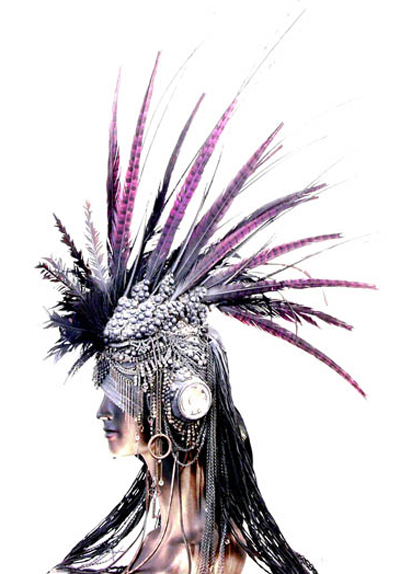Winter Poem
Trunk animations strange and visually dense Winter Poem, animated anddirected by Rok Predin, with a lovely score by Ivan Arnold. If I am being honest, I’m not sure I know what is going on, but it certainly is nice to look at.
Via Drawn!
Trunk animations strange and visually dense Winter Poem, animated anddirected by Rok Predin, with a lovely score by Ivan Arnold. If I am being honest, I’m not sure I know what is going on, but it certainly is nice to look at.
Via Drawn!


The campaign slogan was “Traditional Goes Digital,” and it included three images: Squaw, Brave and Chief. These were created for Australian printing company ColorChiefs in 2006, and recently resurfaced on the How to Be a Retronaut blog, to such wry comments as “Native American steampunk use ALL the parts of the 8088.” The images have also garnered some critique, both for their cultural appropriation and sexism. As blogger Ikwe recently wrote on Tumblr, “it’s not very creative to sexualize a native woman in this way but it’s packaged with a new futuristic sexy theme so it’s sooooo groundbreaking and chic. Oh yes, the ad also reminds us that we are moving forward from our primitive and savage ways. Meh.” Paging Dr. Adrienne!
Looking at this somewhat clueless ad campaign did lead me through an interesting Wikipedia tunnel. Come with me on a magical journey:
Cargo Cult on Wikipedia:
With the end of the war, the military abandoned the airbases and stopped dropping cargo. In response, charismatic individuals developed cults among remote Melanesian populations that promised to bestow on their followers deliveries of food, arms, Jeeps, etc. The cult leaders explained that the cargo would be gifts from their own ancestors, or other sources, as had occurred with the outsider armies. In attempts to get cargo to fall by parachute or land in planes or ships again, islanders imitated the same practices they had seen the soldiers, sailors, and airmen use. Cult behaviors usually involved mimicking the day to day activities and dress styles of US soldiers, such as performing parade ground drills with wooden or salvaged rifles.[5] The islanders carved headphones from wood and wore them while sitting in fabricated control towers. They waved the landing signals while standing on the runways. They lit signal fires and torches to light up runways and lighthouses.[citation needed] In a form of sympathetic magic, many built life-size replicas of airplanes out of straw and cut new military-style landing strips out of the jungle, hoping to attract more airplanes. The cult members thought that the foreigners had some special connection to the deities and ancestors of the natives, who were the only beings powerful enough to produce such riches.
Which led to Cargo Cult Programming on Wikipedia:
A style of computer programming that is characterized by the ritual inclusion of code or program structures that serve no real purpose. Cargo cult programming is typically symptomatic of a programmer not understanding either a bug he or she was attempting to solve or the apparent solution (compare shotgun debugging, voodoo programming).[1] The term cargo cult programmer may also apply when an unskilled or novice computer programmer (or one not experienced with the problem at hand) copies some program code from one place and pastes it into another place, with little or no understanding of how the code works, or if it is required in its new position.
Voodoo Programming on Wikipedia:
In computer programming, deep magic refers to techniques that are not widely known, and may be deliberately kept secret. The number of such techniques has arguably decreased in recent years, especially in the field of cryptography, many aspects of which are now open to public scrutiny. The Jargon File makes a distinction between deep magic, which refers to (code based on) esoteric theoretical knowledge; black magic, which refers to (code based on) techniques that appear to work but which lack a theoretical explanation; and heavy wizardry, which refers to (code based on) obscure or undocumented intricacies of particular hardware or software. All three terms can appear in source code comments of the form:
Deep magic begins here…
In fiction, the term comes from The Lion, the Witch and the Wardrobe, an early book from C. S. Lewis‘s The Chronicles of Narnia, which describes ancient laws and codes as “deep magic from the dawn of time.”
[via m1k3y]



This month, timeless alien beauty Tilda Swinton (the polyamorous, gender-defying star best known for starring as the hero/heroine of Orlando, based on the Virginia Woolf novel of the same name) appeared in a photo shoot for W Magazine by Tim Walker inspired by David Bowie’s The Man Who Fell to Earth. In the interview accompanying the shoot, Swinton cites both Bowie and her father as figures who influenced her style. “They are individuals with whom I share the same planetary DNA,” she says. Of her father’s uniforms, Swinton says: “from childhood, I remember more about his black patent, gold livery, scarlet-striped legs, and medal ribbons than I do of my mother’s evening dresses. I would rather be handsome, as he is, for an hour than pretty for a week.”
This is not the first time that Tilda Swinton has appeared in a David Bowie-inspired shoot. Previously, she emulated Ziggy Stardust-era Bowie in a 2009 shoot with Craig McDean.
I don’t know if I’ll ever understand Tilda Swinton being a Roman Polanski apologist, but these photos sure are stunning.



Courtesy of the wonderful, search talented tykylevits, producer of fine Finnish nonsense for four years and counting.

One Canadian crooner’s Top 40 banality yields another Bad Lip-Reader’s jejune BRILLIANCY:
via Sarah Blue
Bad Lip-Reader’s Black Eyed Peas, Ludacris/BeeGees and Taylor Swift piss-takes are sidesplitting as well.
“Russian Unicorn” lyric sheet after the jump.



Jocelyn Marsh wearing a headdress by Tiffa Novoa. Photo by Brion Topolski. 2005.
Recently, Jenka Gurfinkel –a longtime mover/shaker in the California indie cirque scene— wrote “Why You’re Wearing Feathers Right Now”, a fantastic personal essay that happens to dovetail nicely (pun intended) with the extensive Tiffa Novoa love fest we ran in Coilhouse Magazine last year. Gurfinkel’s unique take on the current exploding trend of plumage in both indie and mainstream fashion is a deft mix of memoir and cultural nodal point-mapping:
“In the summer of 2011, feathers have become a staple of every sartorial and tonsorial aspect imaginable. The other day I was asked my opinion as to where this current ubiquity of feathers has come from. But as it turns out, I happen to have something better than an opinion: I have an explanation.”

El Circo performer at Burning Man, 2005. Photo by Siouxzen Kang.
“Just two years out of college, I stumbled into the role of production manager for a newly-formed, L.A.-based vaudeville cirque troupe called, Lucent Dossier. Through that initial involvement with Lucent I would meet many other circus groups, including El Circo, who were by then based in San Francisco along with The Yard Dogs Road Show and Vau De Vire Society. There was also March Fourth Marching Band in Portland, Clan Destino in Santa Barbara, and Cirque Berzerk, and Mutaytor in L.A. As these acts grew, the I-5 Freeway became a central artery of culture, pumping a distinct combination of art, music, fashion, and performance up and down the west coast. A social scene evolved around these circus troupes the same way the punk subculture sprang up around the bands that defined it.”

Full page Issue 05 Coilhouse spread of performer Joshua David wearing a Ernte feather headdress by Tiffa Novoa. Photo by Spencer Hansen.
“In the early to mid-aughts (when the photos above were taken) the feather was as de rigueur a cultural signifier within the circus scene as the safety pin was for punks in the late 1970s and early 80s. In fact, back before it was so commonplace as to lose meaning (or induce a national feather shortage), condescending terms for those sporting the look sprang up within the subculture: “Feather mafia,” was one I heard thrown around; ‘Trustafarian peacock‘ even made it into UrbanDictionary.com. And then, something else began to happen…”
View the full essay at Social Creature dot com.
As far as this ubiquitous trend of wearing feathers goes– if you adorn with birdie bits, please consider researching where they come from! Buying ethically and responsibly is beautiful. Here are some great resources:



I would venture that there are few phrases that stimulate the brain-meats of journalists or bloggers more than “Nazi sex dolls”. It is an idea so rife with possibility that it is nigh irresistible. The Daily Mail, in fact, just recently found itself under its powerful sway when it published this article, detailing the findings of one Graeme Donald, author of Mussolini’s Barber: And Other Stories of the Unknown Players who Made History Happen, who stumbled upon this tantalizing bit of information while researching the history of the Barbie doll. Barbie, in case you do not know, was originally modeled on Lilli (pictured here courtesy of The Daily Mail), a 1950s German sex doll.
Donald claims to have uncovered evidence relating to the “Borghild Project”, a program set up by Adolf Hitler and the Nazis in order to make a doll who could satisfy the desires of their soldiers on the front and, in turn, help them to avoid being sidelined by the venereal diseases passed onto them by (The Daily Mail specifies) French prostitutes.
The dolls were apparently trialled in Nazi-occupied Jersey at the German barracks in St Hellier.
After being refined, Himmler was so impressed he immediately ordered 50 of them.
However, at the beginning of 1942 he changed his mind and the whole project was axed and any evidence was destroyed in the Allied bombing of Dresden.
The story came from German sculptor Arthur Rink, one of the men on the team which designed the doll at the Racial Hygiene and Demographic Biology Research Unit.
The plan referred to the dolls as “gynoids” and were said to be “smaller than life-size” (again, quoting The Daily Mail).
So, you can see the allure here, right? Hitler commissioned lilliputian sex dolls for Nazi troops. How could you not want to publish that story? Everyone wants to run that! It possesses a bizarre, fucked up perfection. And so, people have. More importantly, people did. In 2005. A quick search shows that Boing Boing’s Xeni Jardin fell under the siren spell of Nazi sex dolls (via Fleshbot who, in true, blogger fashion, appended a question mark to their headline to give themselves an out (NSFW)) just a month shy of 6 years ago. She was quickly disappointed thirteen days later, when it was argued that the story was, instead, a hoax. She was, perhaps, just as disappointed as I was when I Googled “Nazi Sex Dolls” upon receiving this link to see if I could beat Boing Boing to the punch. DAMN YOU JARDIN!
So now the question is: Is it a hoax? Has Graeme Donald found actual proof of the fabled “Borghild Project” or have both he, and The Daily Mail, and about a dozen others (including Gawker, no question mark this time) simply given in to the temptation of writing about lilliputian Nazi sex dolls, something for which I can hardly blame them? Could it be that I have become part of some sort of recursive hoaxing? I very much hope it is the first. History that weird should always be true.
Thanks, Pete!


Illustrator Tom Gauld, best known for his regular contributions to The Guardian, creates quirky, sometimes deeply poignant comic strips. There’s a little something for everyone: robots, dinosaurs, monsters, ghostly shades, Gilliamesque factory machines, baboon ladies… it’s good stuff!
He also has gorgeous screenprints, postcards, shirts and books for sale. Click over to Gauld’s Flickr to take a peek into the pages of his personal sketchbooks, revealing his fascinating creative process.


First, there was Eduard Kihl. Then, there was Trololo Cat. Now, there’s this:
(Via Ariana Osborne. All due love and respect to the incredible Christopher Lee, but I trololol’d.)
